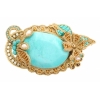|
 Mountain green
aka malachite is one of the natural minerals with patterns that are so admired.
Since early times malachite was considered as the mineral that is able to
recover the serenity of mind, sobriety and give the skill to take willful and
wide decisions. According to ancient traditions, malachite is the stone of
physicians and scientists and symbolizes accomplishment of desires. Malachite
is known from the ancient times and it was highly popular from that time. The most
ancient malachite item is the pendant from the neolithic cemetery in Irak. Mountain green
aka malachite is one of the natural minerals with patterns that are so admired.
Since early times malachite was considered as the mineral that is able to
recover the serenity of mind, sobriety and give the skill to take willful and
wide decisions. According to ancient traditions, malachite is the stone of
physicians and scientists and symbolizes accomplishment of desires. Malachite
is known from the ancient times and it was highly popular from that time. The most
ancient malachite item is the pendant from the neolithic cemetery in Irak.
The decorations
are over 10500 years old. In the suburbs of Jericho malachite beads were found aged about
9000 years. Another famous decoration is the malachite gem with the head of
Izida Goddess, the splendid item. Those times people were attracted by the
magnificent beauty of malachite and elegant landscape patterns. Yet, the solar disc
trimmed in copper especially carved from malachite attracts good luck and is
the strongest talisman for happiness.
Ancient Egyptians
highly appreciated malachite for its green color since this color symbolized
peace and eternity. Also malachite was used as the thing to cal down, and Neron
would cause the malachite powder mix with sand and spread around the circus
stage for peace purposes. Though they say that the Emperor intended to attract
authority and popularity rather than peace for malachite is able to raise the
interest to its owner and supply the energy of Venus and Pluto.
It is
curious but in ancient times malachite was widely used in cosmetics as well as
for hygienic purposes in spite of its honor to the stone and its magic
properties. For instance, the grinded malachite mixed with grease was used as
eye-shadows in Ancient Egypt. Though, not only the issue of beauty mattered. The
point is that sharp and dry winds cause irritation of eye mucosa and
inflammation of eyelids. Malachite (copper salts) has antibacterial properties and
«makeup» based on malachite protected eyes from sand and dust and prevented
from various inflammatory processes.
During Middle
Ages malachite was not that popular as in the past because rich deposits of the
mineral were not discovered. As the consequence, the malachite was said to have
more magic properties than in Ancient Egypt. The green color of the mineral,
the symbol of growth and life, provoked that the stone became the amulet for
pregnant women for malachite was believed to relieve delivery. A piece of
malachite was attached to kids' beds to protect from evils and supply quiet,
peaceful and sweet dreams for babies. In Germany malachite was considered ad
the amulet of horsemen and those who worked on the height, since by
superstitions of medieval people the stone prevented from falling from high.
Also malachite was believed to predict events and grieves when it fell down
into pieces before any bad events.
Boetsiy de Boodt,
the author to «History of Precious Stones» (1603) stated that the sign of the
sun engraved on the malachite protects from wicked enchantments and poisonous
creatures. There was another myth that a
properly made malachite talisman could make a person invisible.
Another belief
is based on the green color of malachite, and those who drink from malachite
cup or eat from malachite dish would understand the language of animals and
birds.
Malachite
became greatly demanded and reputed when it was abundantly discovered in the
Urals (Gumeshkovskiy mine) in the end of XVIII century. after the rich deposits
of malachite were mined, it kept the dominant position among other minerals as
the decoration stone for palace interior and was widely used to manufacture
jewelry.
Unfortunately,
malachite is currently not used widely since deposits are developed and
only
little malachite is used to manufacture columns, vases or doors. Now
this mineral is widely used toproduce jewels.
Pendants and brooches,
rings and earrings, bracelets and other jewelry is what we have made
from malachite these days though it is still highly demanded and
popular.
Inessa Hyder
|